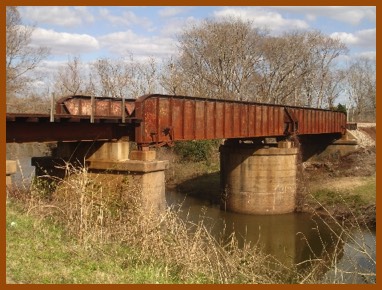Currently viewing
Menu
Atmospheric Corrosion
Atmospheric Corrosion - is the most prevalent form of corrosion, and represents a high component of the cost of corrosion.

Photograph of a Railway Bridge
Exposed to the Atmosphere
Atmospheric Corrosion is electrochemical in nature, and therefore requires the presence of an electrolyte. The formation of an electrolyte on the surface depends on: the Relative Humidity (RH) - the physical nature of the surface - and the chemical nature of the surface.
The humidity below which corrosion will NOT occur is generally termed the Critical Humidity (CH). This value is different for different metals, as well as for differing conditions. The CH can change as a function of the development of corrosion products on the surface of a metal.
Atmospheric Corrosion represents the most likely environment in which General Corrosion will be the mode of degradation. Because Atmospheric Corrosion is electrochemical in nature, it requires the development of a moisture film or droplet. This results in a concept termed the Time of Wetness, which is a complex variable delineating the time during which corrosion can progress because of the presence of moisture on the surface of a metal.
For corrosion in aqueous systems, the diffusion of oxygen can limit the rate of degradation. In the case of Atmospheric Corrosion, oxygen access is not a limiting factor because the moisture film is thin.
Both the physical and chemical nature of a surface can alter corrosion. Capillaries (e.g. - pits, pores, crevices etc.) will stabilize moisture more readily than a flat surface. Particulates on the surface may exacerbate corrosion - either because they stabilize a moisture film (even if inert) OR because the particulate is an aggressive species.
Atmospheres are typically labelled: Industrial - Marine - Rural - Indoor. Marine environments may be contaminated with sea salt, while industrial environments generally contain sulfur and nitrogen contaminants which are not present in the case of a rural environment. Indoor atmospheric corrosion may be attenuated relative to outdoor conditions, but the presence of pollutants from glue, plastic, wood, etc. can potentially result in conditions that are as severe as those found outdoors.
The humidity below which corrosion will NOT occur is generally termed the Critical Humidity (CH). This value is different for different metals, as well as for differing conditions. The CH can change as a function of the development of corrosion products on the surface of a metal.
Atmospheric Corrosion represents the most likely environment in which General Corrosion will be the mode of degradation. Because Atmospheric Corrosion is electrochemical in nature, it requires the development of a moisture film or droplet. This results in a concept termed the Time of Wetness, which is a complex variable delineating the time during which corrosion can progress because of the presence of moisture on the surface of a metal.
For corrosion in aqueous systems, the diffusion of oxygen can limit the rate of degradation. In the case of Atmospheric Corrosion, oxygen access is not a limiting factor because the moisture film is thin.
Both the physical and chemical nature of a surface can alter corrosion. Capillaries (e.g. - pits, pores, crevices etc.) will stabilize moisture more readily than a flat surface. Particulates on the surface may exacerbate corrosion - either because they stabilize a moisture film (even if inert) OR because the particulate is an aggressive species.
Atmospheres are typically labelled: Industrial - Marine - Rural - Indoor. Marine environments may be contaminated with sea salt, while industrial environments generally contain sulfur and nitrogen contaminants which are not present in the case of a rural environment. Indoor atmospheric corrosion may be attenuated relative to outdoor conditions, but the presence of pollutants from glue, plastic, wood, etc. can potentially result in conditions that are as severe as those found outdoors.
Currently viewing
Page last updated: 3/4/25
